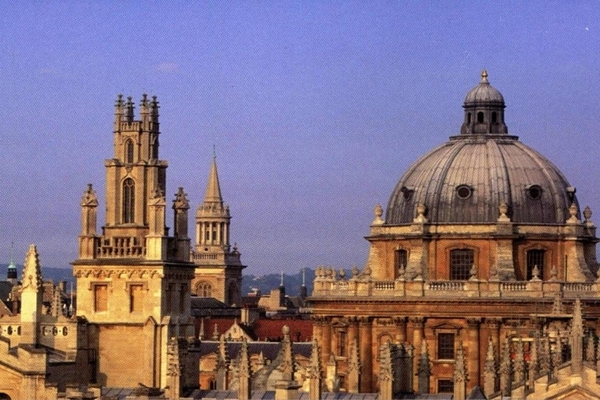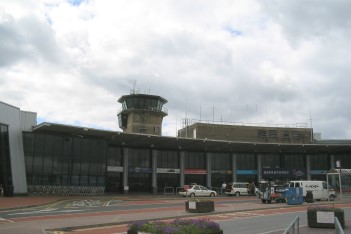County town of Oxfordshire, and the home of the oldest English speaking university in the world, Oxford is one of our most popular destinations to explore from the air in the UK on our special Oxford City Dreaming Spires Helicopter Tour packages we have available to book here on FlyDays.
This helicopter tour is so named after the line from ‘Thyrsis’, a piece by Victorian poet Matthew Arnold, who referred to Oxford as the ‘city of dreaming spires’. But as you’ll discover, there is more to this historic city than a world renowned university, with our guide to some of the best landmarks to view from the skies above the spires…
Easily the most recognisable landmark in the city, the Radcliffe Camera - or ‘Rad Cam’ for locals and countless amounts of students since - stands proud amongst the old University campus. Designed by the neo-classical architect James Gibbs, and built between 1737 and 1749, it was constructed to accommodate the Radcliffe Science Library.
This majestic circular building, with its magnificent dome and towering pillars is, we dare say, what Matthew Arnold felt compelled to describe as a ‘dreaming spire’ when he first saw it from the nearby village of Boars Hill whilst writing ‘Thyrsis’.
Uncommon from other buildings at the university, it stands alone, and it is this which means that, in visual depictions in literature and other media, it has always been something of a shorthand emblem for the university, which ensures it continues to be known globally.
Up until about 1810, it housed a collection of books from all different subjects, but after George Williams took over from Francis Wise as the librarian, it narrowed its collection down to science focussed titles instead. The Radcliffe Science Library was eventually moved to another building on campus in 1850, after which time the Camera - derived from the Latin for ‘room’ - became the reading room of the Bodleian Library.
Situated to the west of the city centre, Oxford Castle was built by the Norman baron Robert D’Oyly the elder between 1071 and 1073. It was originally a wooden motte and bailey castle, as common with other similar buildings of the time, but some time around the 12th or early 13th Century, it was reconstructed in stone.
It played a crucial role in the Anarchy Civil War from 1135 to 1153, but by the 14th Century, its military and defence uses had lessened. And with the English Civil War seeing to it that much of the original castle was destroyed, by the 18th century the remainder of the building had come into use as HM Oxford Prison, which saw a new prison complex erected on the derelict site.
The prison was closed in 1996, but the castle still remains a popular tourist attraction in the city. What remains of the old medieval castle, including the motte and St George’s Tower, which is actually believed to pre-date the old remains when it was a watch tower for the old Saxon west gate to the city, are Grade I listed buildings.
Britain’s oldest botanical garden is situated right in the heart of Oxford, and is also one of the oldest scientific gardens in the world. Founded in 1621 as a physic garden (which specialises in herbs with medicinal properties), Oxford Botanical Gardens houses over 5000 different species of plants across 1.8 hectares - equivalent to three football pitches!
The English sculptor and architect Nicholas Stone designed and built the famous Denby Gateway, one of the three entrances to the garden, between 1632 and 1633, and it is one of the earliest examples of a building in Oxford to utilise the classical/early Baroque style of design.
The garden itself is divided into three specific sections; the Walled Garden, which is also the site of its oldest tree, an English Yew, the glasshouses, which play a vital role in the cultivation of plants that are more sensitive to the extremes (and then some) of British weather, and the Lower Garden.
Lewis Carroll took great interest in and inspiration from the garden when writing his novel Alice’s Adventures in Wonderland. In fact, early copies of the book, with illustrations by Sir John Tenniel, depict the garden’s glasshouse for water lilies in the background of the colour plate titled ‘The Queen’s Croquet-Ground’.
Not to be confused with the bridge of the same name in Venice, Italy (although very much an affectionate nod in its direction), the Bridge of Sighs is another of Oxford’s key landmarks, and was designed by architect Sir Thomas Jackson to connect the new and old Quadrangles of Hertford College on New College Lane, just off Catte Street.
It was completed in 1914, despite strong opposition from New College at the time. In fact, if you believe the legend, it proved a sore sticking point for students at Hertford College, who were deemed to be the heaviest following a health survey conducted by the student body not long after work on the bridge finished.
It is suggested that they were thus banned from using the bridge and ordered to take the stairs instead to get some exercise; this despite the fact that said students would actually have to have taken fewer stairs in the event!
The Bridge is still in use by the University today, and is a Grade II listed building, with the newer quarters housing Hertford College’s administrative functions, and the older quarters being used as student accommodation.
Oxfordshire’s close proximity to Berkshire, and the flowing of the River Thames (or Isis) through part of the city has always given Oxford a natural connection to those who, in the famous words of Kenneth Grahame’s much loved 1908 children’s book The Wind in the Willows, love ‘simply messing about in boats’.
Along part of a stretch of the river, near the Jericho and Wolvercote boroughs of the city, lies Port Meadow, an open common land which is also ancient grazing territory, and is believed to have not been ploughed in over 4000 years.
History records that, in return for helping defend the kingdom against the marauding Danes, Alfred the Great bequeathed the 300 acres of land to the Freemen of Oxford. Furthermore, the Freemens’ right to graze their animals free of charge was recorded in the Domesday Book of 1086, which still stands to this day.
A typically English flood-meadow, nowadays Port Meadow is a popular recreational spot for those who live in the area, used for activities like walking, running, cycling and wild swimming in the river. It is particularly beautiful to see in the late spring, when the meadow is covered with buttercups, and many bird watchers often come here too.
So as you can see, Oxford offers many dreamy sights beyond its majestic spires, but don’t just take our word for it. Book yourself onto FlyDays’ selection of Dreaming Spires helicopter packages today from forthcoming dates or purchase of our open gift vouchers via our Helicopter Tours page, starting from £149!



